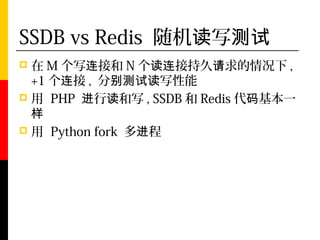Ad
SSDB(LevelDB server) vs Redis
- 1. SSDB(LevelDB) vs Redis ideawu https://code.google.com/p/zdb/
- 2. 问题 数据有 : a, b, c, d, e(5 个单位 ) 内存容量 : 4 个单位 硬盘容量 : 100 个单位 问题 : 内存放不下所有数据 数据可以放硬盘 , 但硬盘较慢
- 3. Redis 存储结构 memory aof(log) a=1 a=1 b=2 b=2 c=1 a=3 d=1 c=6 a=1 e is LOST! d=7 e=3 d=1 b=2 c=3 a=1 c=1
- 4. Redis 查找 先查找内存 如果内存中没找到 , 那就真的没找到 上例中 , e 因内存容量限制被丢弃了 ...
- 5. LevelDB 内部存储结构 memory log level 0 ... level n a=1 a=1 a=3 a=1 b=2 b=2 b=2 b=2 c=1 a=3 c=6 c=1 d=7 c=6 a=1 a=1 d=7 d=7 d=7 e=3 e=3 e=3 d=1 b=2 a=1 c=3 b=2 a=1 c=1 c=1
- 6. LevelDB 查找 先查内存 直接跳过 log, 查 level0 level0 有重叠 , 从新到旧查找 查 level1...
- 7. Redis 和 LevelDB 简单介绍 Redis 网络字典服务器 除 KV, 支持丰富的数据类型 , 如 list, zset 在互联网公司有广泛应用 C 语言开发 LevelDB Google 公司 Bigtable 系统存储引擎的开源版本 KV 存储 , 数据有序 应用不广泛 , 作为 Chrome 的内嵌存储引擎 , 作为一 些开源分布式系统的存储引擎 C++ 语言开发
- 8. Redis vs LevelDB Redis LevelDB 持久化存储 写速度快 完全内存查找 , 速度极快 若内存找不到 , 再找硬盘 , 速度受影响 网络支持 只是一个 C/C++ 编程语言库 受限于内存容量 , 硬盘只作为备份 存储容量不受内存容量限制 , 依赖硬盘 主从同步机制不完善
- 9. SSDB - LevelDB 服务器 基于 LevelDB 引擎封装网络服务 (epoll) 替代 Redis 或者和 Redis 搭配使用 支持 Redis 的常用关键数据结构 客户端 API 与 Redis 相似
- 10. SSDB vs Redis
- 11. SSDB vs Redis 随机读写测试 在 M 个写连接和 N 个读连接持久请求的情况下 , +1 个连接 , 分别测试读写性能 用 PHP 进行读和写 , SSDB 和 Redis 代码基本一 样 用 Python fork 多进程
- 12. 随机读写 – 0 写 0 读 +1 测
- 13. 随机读写 – 1 写 4 读 +1 测
- 14. 随机读写 – 2 写 8 读 +1 测
- 15. 随机读写 – 3 写 12 读 +1 测
- 16. 随机读写 – 4 写 16 读 +1 测
- 17. SSDB Redis 命令对比 - KV keys() 返回全部数据 , scan() 支持分页
- 18. SSDB Redis 命令对比 - ZSET zRangeByScore(name, score_start, score_end, options); zscan(name, key_start, score_start, score_end, limit);
- 19. SSDB Redis 命令对比 - HASHMAP SSDB 的 hkeys/hscan 支持分页
- 20. 支持断点续传的主从同步 Redis 的主从同步一旦异常中断 , 就得从头再来 SSDB 可以从上一个断点开始同步
- 21. TODO 性能 分布式
- 22. 链接 https://code.google.com/p/zdb/ https://code.google.com/p/leveldb/ http://redis.io/ https://github.com/ideawu/ssdb
- 23. FIN Thanks












































































